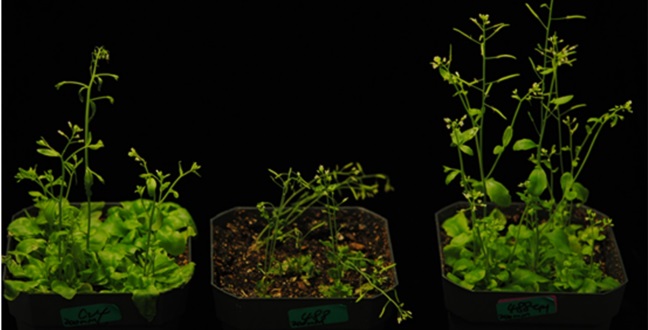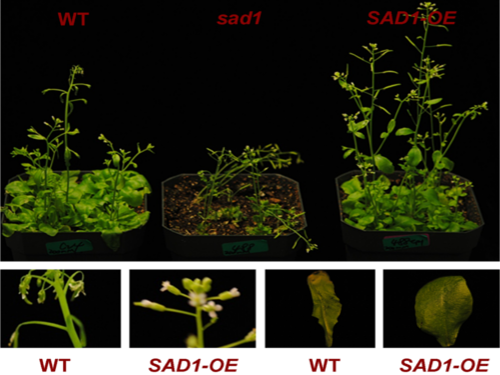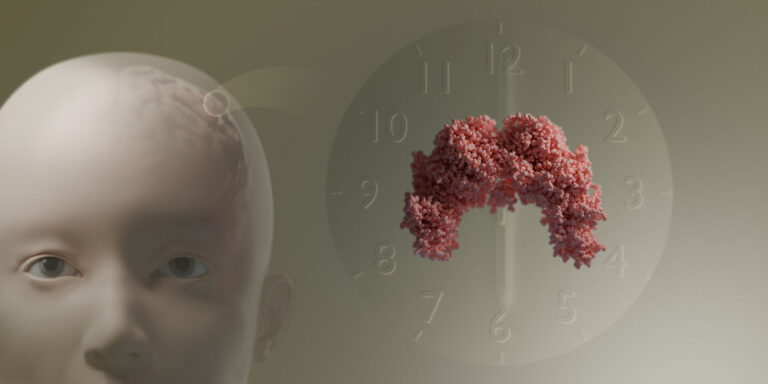Bioscience
Plants coping with salt stress
Discovery of the molecular mechanism by which a protein confers salt tolerance in plants could boost crop yields in high-saline soils.


How Arabidopsis plants look like when Sad1 – the gene encoding the protein LSm5 – is knocked down (sad1), compared to plants where Sad1 is overexpressed (SAD1-OE) and the wild type (WT).
© Xiong et al.
The role of protein LSm5 in regulating accurate and specific splicing across the genome, particularly of genes involved in salt stress tolerance, has been revealed by a team of researchers from KAUST.
To express any gene in the cell, the encoding DNA is first transcribed to pre-messenger RNA (pre-mRNA). Prior to this any intermittent non-coding parts must be removed before mature mRNA can be exported and translated. This removal process, known as pre-mRNA splicing, can occur at several sites, which explains why a single gene is able to encode several different proteins.
Splicing is carried out by the spliceosome, a complex molecular machine which is made up of many different proteins and RNA particles. One of those proteins was known to be LSm5 although researchers were unsure of its exact function in splicing. Also unclear was the regulatory mechanism by which a specific spliced product is produced accurately.
Led by Liming Xiong, a team from the Biological and Environmental Sciences and Engineering Division carried out genetic screens on Arabidopsis plants — a commonly used model— to find an lsm5 mutant in which the lsm gene function is turned off. They also generated transgenic plants overexpressing the normal LSm5 gene. Next they sequenced the full set of mRNA produced by the plant, known as the transcriptomes, and compared the results of the lsm5 mutant plant with the wildtype and the overexpressor.
The team found that the lsm5 mutant had a higher frequency of alternative and inaccurate splicing, compared to the wildtype. Conversely, overexpression of LSm5 resulted in precisely the opposite, suggesting that LSm5 plays a role in regulating specificity and accuracy. On closer inspection, they found salt-stress related genes were particularly affected.
As well, the team could show the growth of LSm-5 overexpression plants was less inhibited by salt stress, phenotypically corroborating what was expected from the transcriptomic results.
This new knowledge, explains Xiong, not only helps clarify a fundamental molecular mechanism necessary in higher life forms, but also provides the key for engineering salt-tolerant plants.
“High soil salinity in the arid and semiarid regions severely limits the productivity of many agricultural plants. Increased plant tolerance to salt stress is an important means to increase crop yields in these regions and could also make irrigation with brackish water possible,” explains Xiong. “This is particularly important for countries like Saudi Arabia where a lack of fresh water has limited its agricultural production.”
References
- Cui, P., Zhang, S., Ding, F., Ali, S. & Xiong, L. Dynamic regulation of genome-wide pre-mRNA splicing and stress tolerance by the Sm-like protein LSm5 in Arabidopsis. Genome Biology, 15, R1 (2014).| article
You might also like

Bioengineering
High value harvests from designer algae

Bioscience
Digging into the world of plant-growth-promoting microbes

Bioengineering
Stray DNA fragments challenge CRISPR precision

Bioscience
Unique microbiome discovered in mountain streams

Bioscience
How a multitasking protein keeps the body’s clock in sync

Bioscience
The theory of everything that wasn’t

Bioscience
Mangrove microbes to munch on plastic

Bioscience



